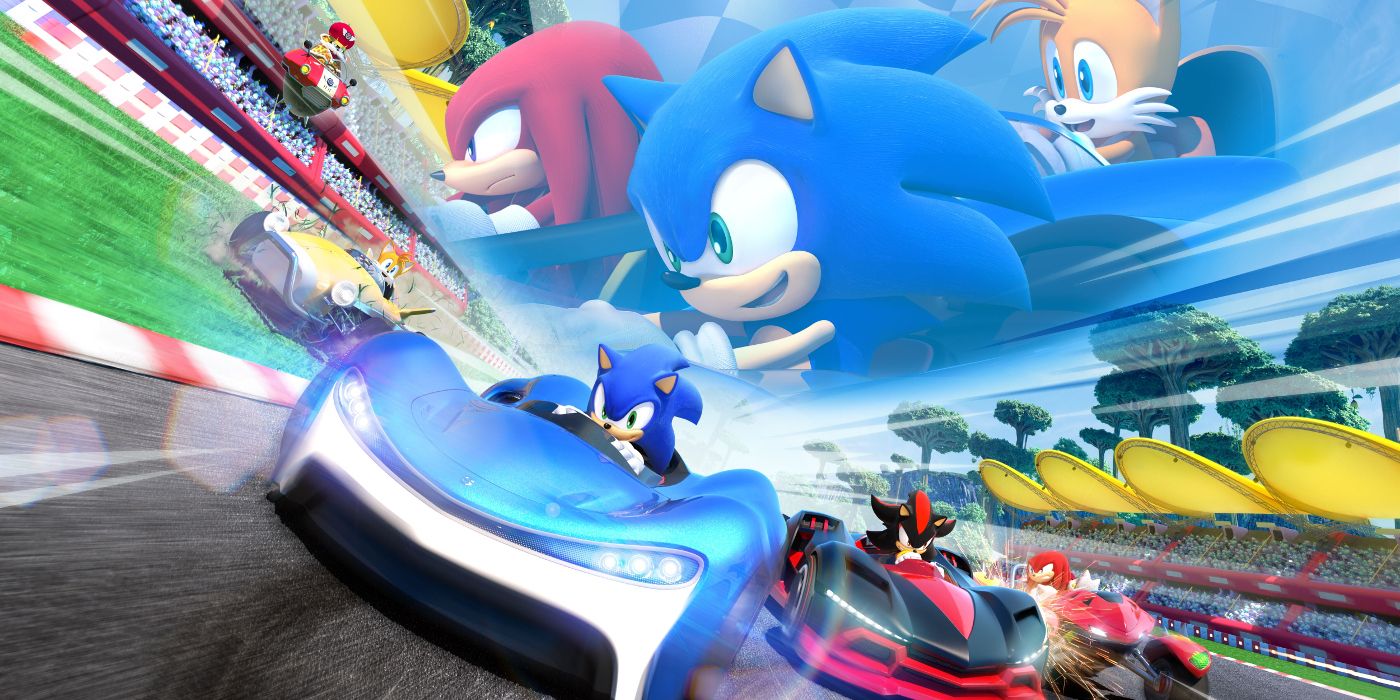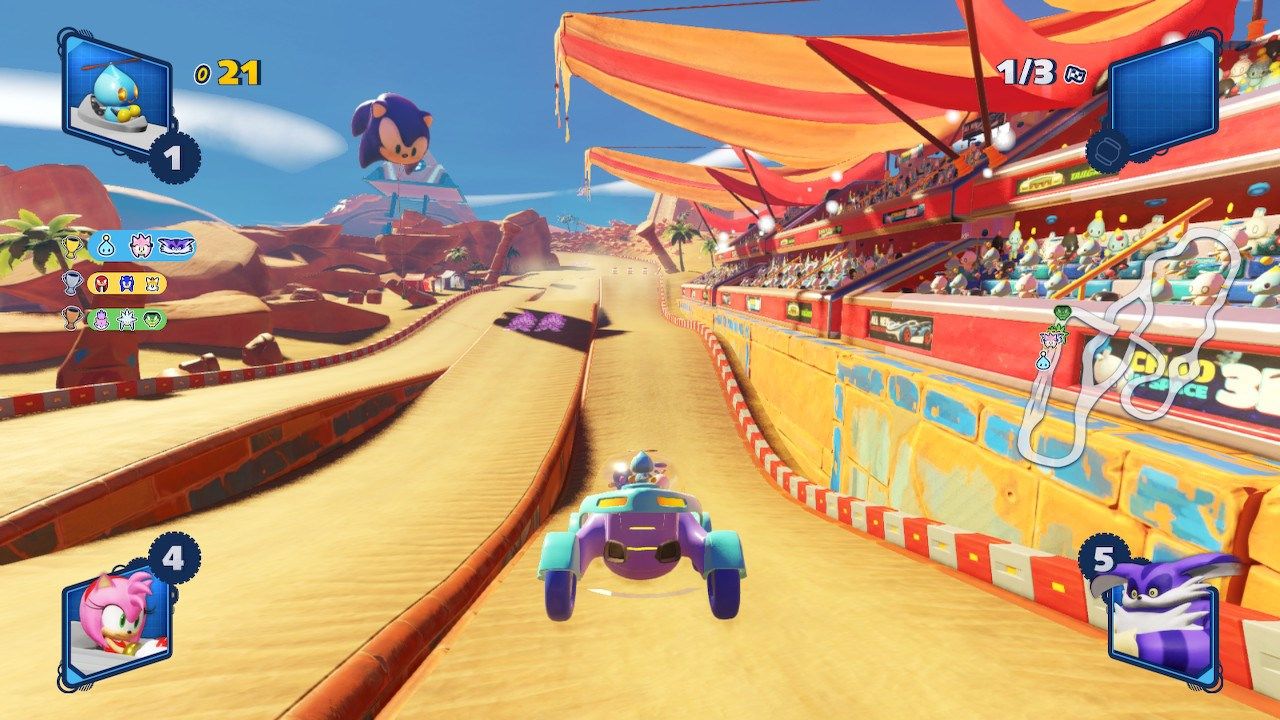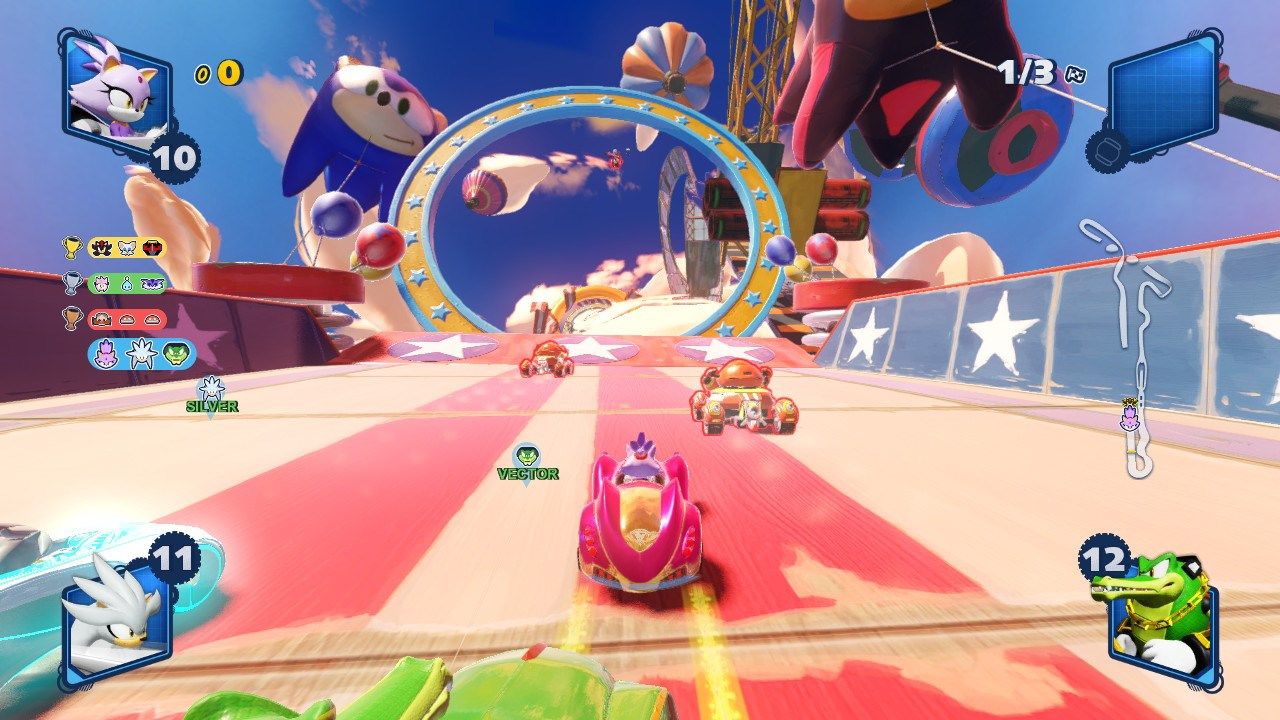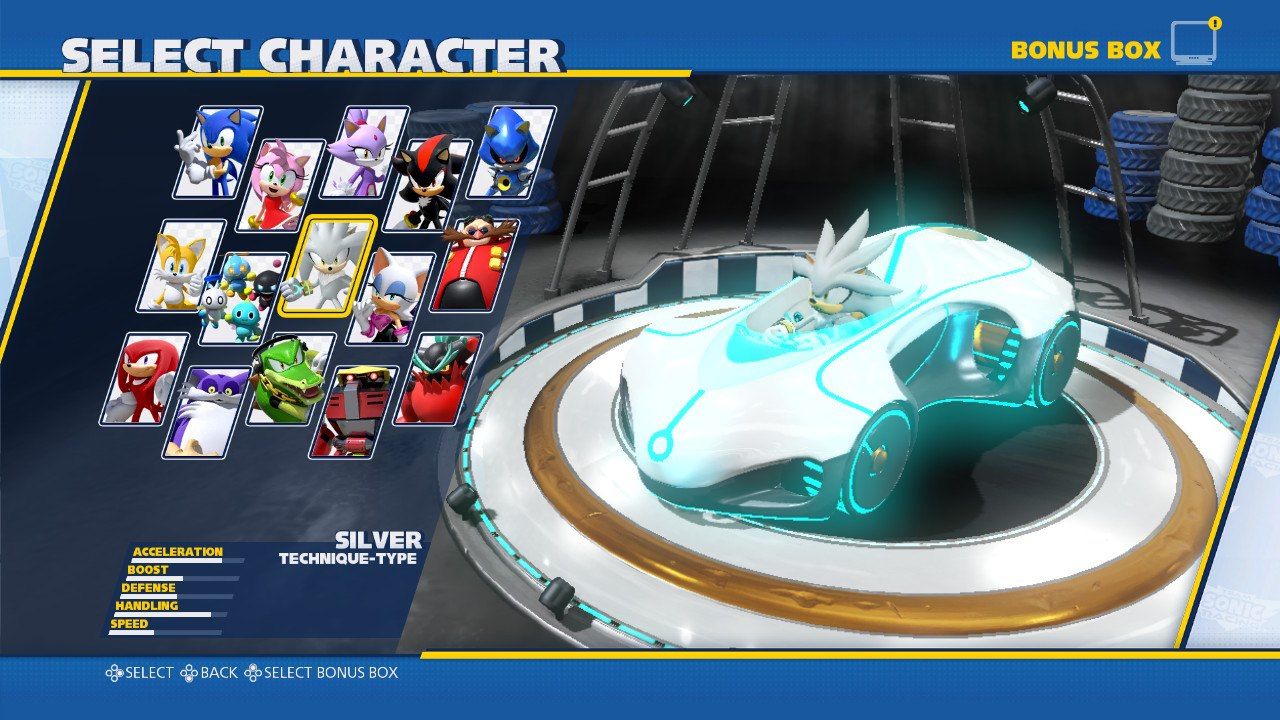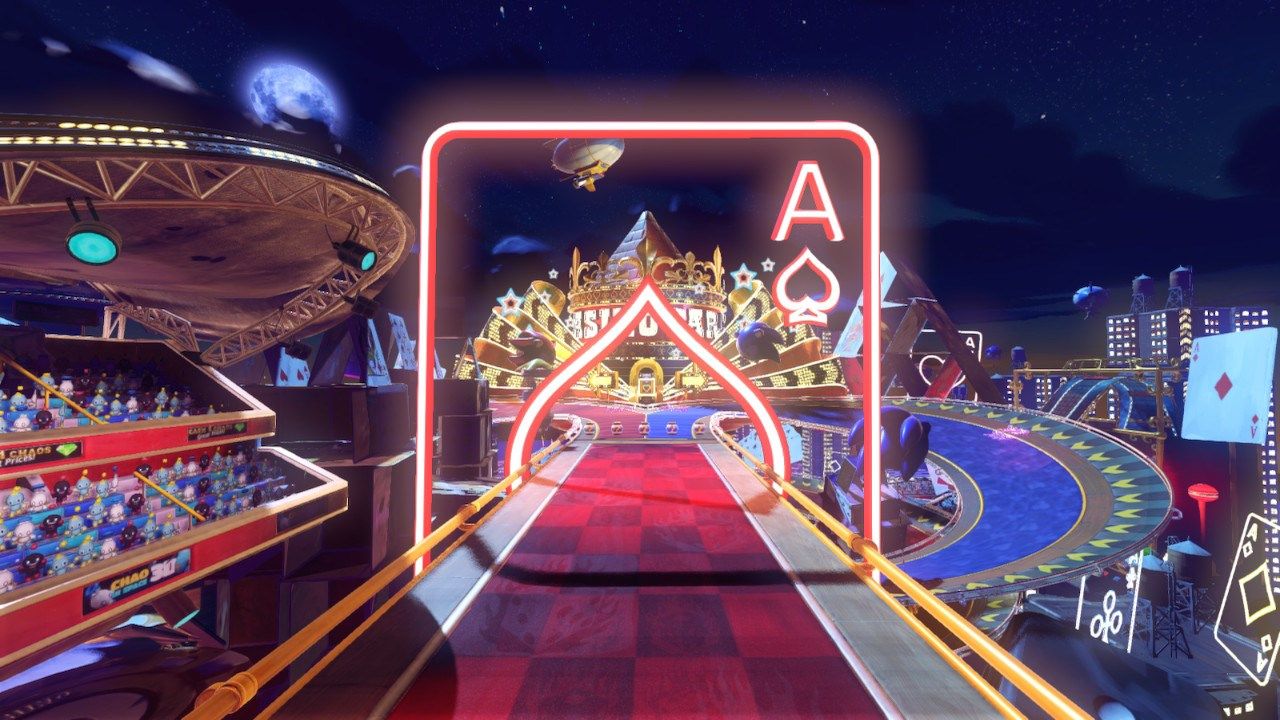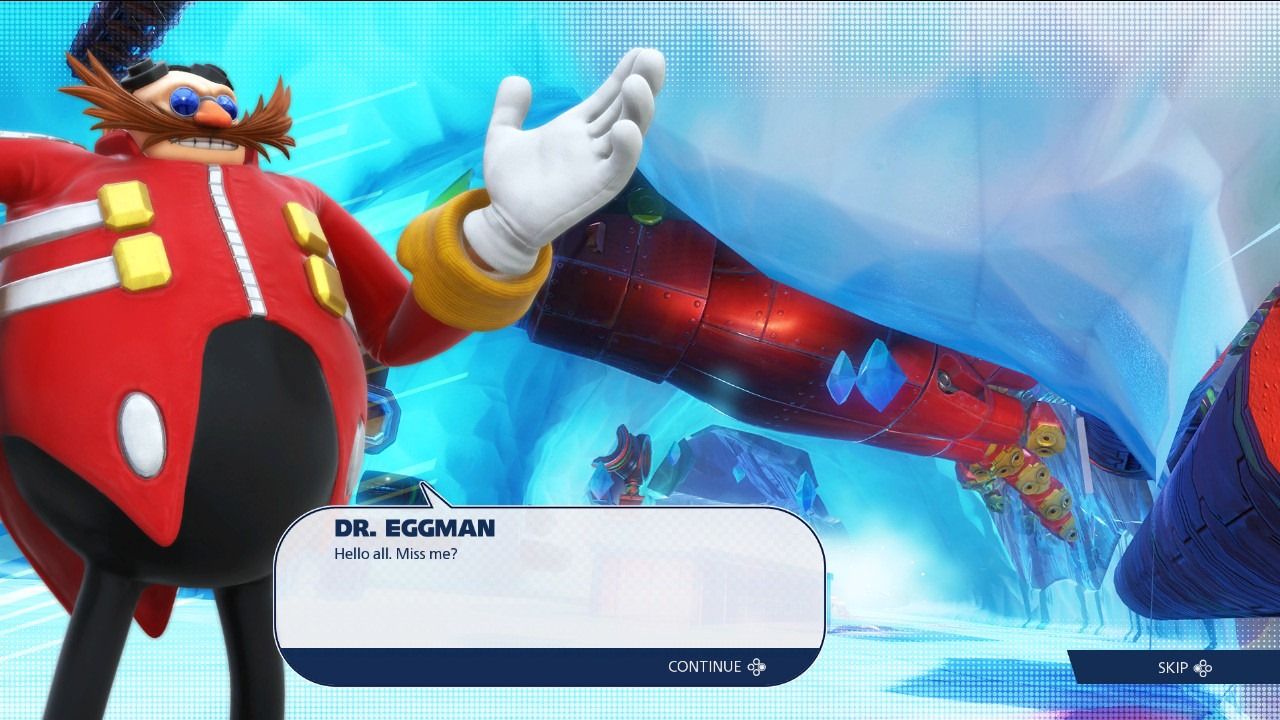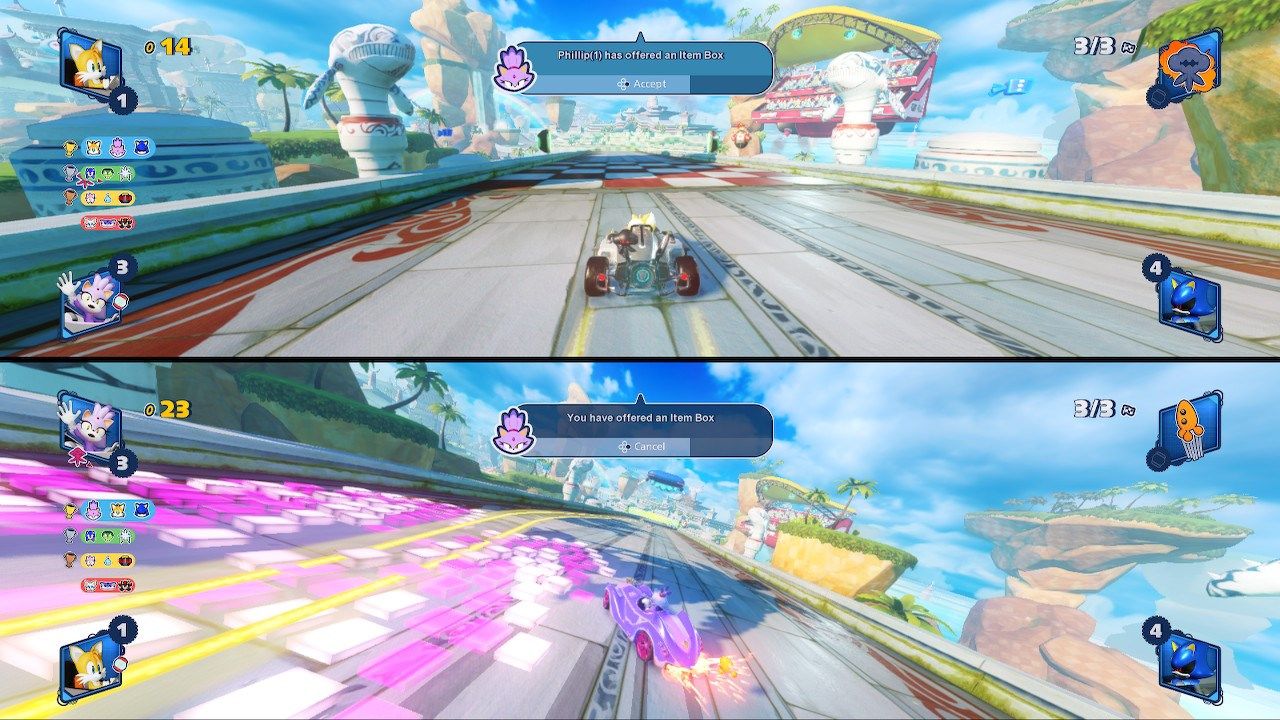Team Sonic Racing's an excellent blend of arcade and kart racing, and its stellar tracks are unmatched. This makes it sadder that no one's playing it.
Aside from the Mario Kart series, new releases in the kart racing genre are few and far between these days. Alongside the upcoming Crash Team Racing Nitro-Fueled, Sumo Digital's Team Sonic Racing is looking to spark a modern comeback for this high-octane type of party game. Though it stumbles here and there, Team Sonic Racing is a solid arcade-like kart racer that makes the most of the Sonic the Hedgehog universe. In addition to packing in enough characters and references from across the Blue Blur's long history to excite fans without putting off newcomers, the game is just plain fun and sets itself apart from the pack with a mixed bag of innovations. Despite its polish and playability, Team Sonic Racing is one of the best kart racers that no one's friends are playing.
Races in Team Sonic Racing are fairly straightforward kart racer fare, challenging players to zoom around colorful, Sonic-themed tracks and beat your enemies to the finish line using skill and various Wisps, living stand-ins for items borrowed from Sonic Colors. There's a catch, though. As the title suggests, team-based racing is the game's premier mode, meaning that the usual individualist attitude toward racing must thrown out of the window if players want to win.
Team Races are split into four teams of three, and to races are scored based on the combined placing of the members of each team. Needless to say, skilled loners that place in the top three with ease but consistently fail to contribute to their teammates' success are liable to lose at the end of a four-course Grand Prix. Luckily, Team Sonic Racing employs a few novel mechanics to make team play possible on the track, including item transfer, skim boosting, and slingshotting.
Item transfer is exactly what it sounds like, letting players request a Wisp from their teammates or pawn off unneeded ones off. Occasionally, a shared Wisp will turn into one of a few forms endemic to item transfer instead of the originally sent Wisp. It's a smart mechanic, and AI teammates cooperate with their human counterparts well enough, but sometimes they exchange Wisps that waste players' time and focus. Meanwhile, skim boosting involves narrowly drifting past a teammate, causing them to shoot ahead with a brief boost. This can be difficult since everyone is moving at varying speeds and directions, but even players who struggle with it will feel its benefits when team members unexpectedly send them jolting forward.
The crown jewel of Team Sonic Racing, however, is slingshotting. The leader of the pack within a team always leaves a yellow trail behind them that grants teammates extra speed, and the longer a player stays in the wake of their pal, the stronger their boost will be when they exit the slipstream. This is a brilliant addition, as it not only encourages players to stick together as a team but also incentivizes players of lower skill to emulate the behavior of their teammates, as well as place themselves in the way of harm when they otherwise would avoid it. Using all of these team mechanics causes a shared meter behind players' cars to fill; once full, they can activate their Team Ultimate, which functions like a communal Mario Kart super star that rewards team play.
In so closely tending to teamwork, some parts of the core kart racer experience seem to have gotten a little less attention. Drifting, for instance, works perfectly as intended and is slightly more lenient than that found in Mario Kart, but the same sense of satisfaction when executing even the most technically impressive of drifts is missing. Like its Nintendo competition, drifting grants three levels of boost based on drift length and intensity. In spite of this near-identical function, the lack of oomph behind cornering in Team Sonic Racing traces back to drifting sound effects and animations that are lackluster compared to those of the more visceral team boosts and boost pads, and this dulls the intended effect.
Wisps, on the other hand, don't slack on the visual or auditory feedback, and landing hits on other racers with green and red shell-like Rockets and Eagles looks and feels great. That said, the game suffers from an abnormally cluttered screen for a party game, displaying a lot of relevant information at all times, and these HUD elements are frequently joined by item transfer prompts and subtitles. (Yes, unfortunately the characters' issue quips often, but this can be turned off or changed to text-only in the game's settings.) Because of this, it can be easy for players still acclimating to the clutter to miss stuff while dodging attention-demanding obstacles and foes, and the mildly distinct, invariably squid-like Wisps are often the first to go unnoticed or unrecognized.
As the creator of the Sonic & Sega All-Stars Racing titles, Sumo Digital clearly has a lot of fun when given free reign with the Sonic license, and they've done the space-faring, anthropomorphic world justice in Team Sonic Racing better than ever before. The 15-character roster is a sizable offering that represents the series' long and diverse history of games, featuring everyone from the original three that started it all to a group of Sonic Adventure 2-era Chao and the more obscure antagonist of Sonic Lost World, Zavok. Granted, there are a few notable absences that fans will surely notice, such as Cream the Rabbit and the rest of Team Chaotix, but these and others may be planned as DLC racers.
In terms of courses, Sumo knocked it out of the park. Sporting 21 courses set that span seven distinct zones, Team Sonic Racing is replete with gorgeous and memorable tracks that keep races interesting hours and hours in. Borrowing imagery and environmental hazards from from past Sonic titles and updating them to look amazing on modern consoles, the game's courses steal the show and may be the first time that a spin-off game outdid the mainline series at its own game. Longtime fans will have waves of nostalgia wash over them as the orcas from Sonic Adventure and Sonic Heroes breach right over them as they speed down tracks painted with the saturated tones and palm trees of Green Hill Zone, as well as when they navigate the stunningly reimagined worlds of the original Sega Genesis games.
As for modes that facilitate racing across Team Sonic Racing's excellent selection of courses, the game has plenty. Of course, there are the expected local and (on Switch) wireless modes, allowing players to compete against AI racers and one another in Grands Prix and Exhibition Matches. The latter gives players greater customization and the choice of ditching team-based gameplay for standard racing. On top of this are several race types, which range from elimination-based Survival, lead-hogging King of the Hill, and a handful of item-specific types. There's also online multiplayer, featuring casual and ranked options for Team and Standard Races with user-voted maps and game types. The online component is just as fun as its split-screen counterpart, but, unfortunately, there weren't many people online at the time of review.
Notably, the game doesn't feature a battle mode - however, considering the dismal battle experience present in Sonic & Sega All-Stars Racing Transformed and the even worse state of Mario Kart 8's Wii U so-called "battle mode," this isn't really a bad thing. Instead, Team Sonic Racing comes with a full campaign centered around a light-hearted (and mostly optional) original story. The campaign, called Team Adventure, is designed to ease players into the game before significantly ramping up the difficulty over time, offering small worlds comprised of levels that players must conquer in order to progress. Half of these are traditional races and Grands Prix, while the rest are challenges that test players' knowledge of the game's mechanics and tracks. Some of these are brutal, but mastering them isn't necessary to progress.
Also new in Team Sonic Racing is full kart customization, allowing players to tweak the stats of their karts with parts unlocked through play, and karts' colors, paint textures, decals, and horns can also be modified. It's by far the most ambitious vehicle editor in a mainstream kart racer, but it's hampered by a couple of annoyances. The first is a fairly small one: the customization menus are too slow due to over-animation. It's no deal-breaker, just mildly irritating. The second, however, is Team Sonic Racing's sole overtly bad decision, and it's directly tied to how those performance-modifying kart parts are obtained.
Despite the fact that Team Sonic Racing has no premium currency or any microtransactions to speak of at the time of release (and likely won't get any such paid content aside from normal DLC expansions), Sumo and Sega thought it wise to force players to unlock semi-random parts and other unlockables using a digital gachapon system called Mod Pods. While users' most-played racers are thankfully taken into account when dispensing character-specific parts, the large pool of unlockables are further watered down with a number of handicap-like boosts meant to be used prior to a race (which themselves are a poor, finite substitute for actual accessibility features). About half the time players spin the proverbial wheel for an item, they'll get a boost instead.
To clarify, the wealth of credits the game throws at players for regular play and the fact that no real money changes hands between players and Sega in the process mean that Mod Pods aren't predatory in any real way. What they are, though, is a pointless nuisance that turns unlocking quasi-random items one-by-one a complete chore. Considering that "legendary" tier items allow players to transform their karts into a gaudy gold in a blatant imitation of Mario Kart's famed 100 percent completion reward, Team Sonic Racing should have also taken a leaf out of Nintendo's book by making these upgrades (and hell, even the boosts) automatically unlock with players' total credits earned.
Mod pods aside, the game's few weak points do little to weaken the thoroughly enjoyable kart racer that they inhabit. Team Sonic Racing is a blast to play alone, online, or at home with friends, and it's more than worth its $40 price tag. Sumo Digital clearly put their all into this one, as its reflected in the game's team racing innovations, high level of polish, and dedication to its source material. As such, it's a shame that the game's online scene is currently desolate, and it wouldn't be an exaggeration to say that what Team Sonic Racing suffers from the most is a poor marketing budget.
Team Sonic Racing is now available on PlayStation 4, Xbox One, Switch, and PC. Screen Rant was provided a Switch code for review.

